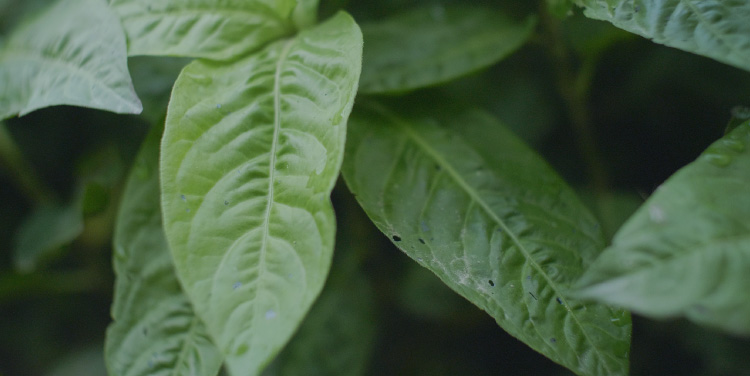

“If native peoples had colors, then the color of the Japanese would surely be Japanese indigo.” —Fukumi Shimura
I took some Japanese indigo cloth in my hand and gazed at it. The color sank into my eyes. First, I saw the deep navy hue and the bottomless ultramarine blue. Then the barely perceptible tones of red and yellow, and green and brown, became audible. While not positively visible, the tones are submerged in the blue and tickle the back of the eye. These may seem like unwanted impurities in comparison with pure chemical dyes, but to human beings, they are like the perfect harmony of a chord. The color is the embodiment of the plant’s life itself, after it grows up from the land, is nourished by the sun and water, and is tended by human hands.
An annual grass called Persicaria tinctoria is used to make Japanese indigo dye. While indigo dye made from blue indigo components in leaves can be found around the world, the Japanese indigo lovingly used mostly in Japan is made from this Persicaria tinctoria.
Persicaria tinctoria is harvested in the summer. The leaves are shredded and dried, and then fermented from fall to winter with frequent stirring to create what is called sukumo. The sukumo is then mixed with lye, lime, and other substances and fermented and reduced. The dye solution is ready after several days when iridescent purple bubbles form on its surface. These bubbles floating up to the surface are called “indigo flowers.”
The dye solution is not an inert substance, but is alive with bacteria. For this reason, if it is not nurtured with care and given nutrients such as Japanese sake and kept at the proper temperature, it can die all too easily. Dead solution is no longer any good for dyeing. The traditional indigo dye color has been created over long years of experience and with nature’s providence.


In the Edo Period (1603–1868), Tokushima Prefecture was called Awa and was the nation’s largest sukumo production center. Each year, the Yoshino River would flood and bring fertile soil to the land that was just right for Persicaria tinctoria cultivation. Awa made high quality sukumo, which gave rise to dyeing traditions in regions all around Japan. Aizome, or Japanese indigo dyeing, was an essential part of life and used with kasuri (ikat technique) and shibori (resist dyeing technique) textiles as well as for farmers’ work clothes. Japanese indigo gave cloth added strength, repelled insects, and more than anything, created beautifully dyed color. Upon seeing all the Japanese people wearing kimonos of Japanese indigo, a foreign scholar who visited Japan in the Meiji Era (1868–1912) dubbed the color “Japan Blue.” No other color came close to being so popularly loved and present in daily life.
When synthetically produced indigo derived from petroleum became popular, however, traditional Japanese indigo painstakingly produced by hand declined almost overnight. By 1966, fields growing Persicaria tinctoria in Tokushima Prefecture had fallen to just 0.03 percent of the land area at their height, creating a crisis of survival. Production has somewhat recovered today, but there are now only five businesses that have sukumo masters who make sukumo. There are few fields as well, and they cannot keep up with demand.
“I think aizome is farm work.”
The sukumo master Osamu Nii says this with certainty. When you touch fresh Japanese indigo leaves in a field, you get a sense of how clothing and dyes all used to be a part of farm work. The allure of natural dyes comes from how they create authentic colors made from the life of plants and traditional skills performed by hand. I want wrap myself in these colors again and feel them against my skin. Japanese indigo deserves a place in our time, and in the following generations as well.
職種:店舗販売 / 営業 / 生産管理 / パタンナー / デザイナー
正社員登用、給与は経験により相談。月20万円以上。
年齢性別不問。
厚生年金、健康保険、雇用保険等完備。交通費支給、賞与。
ご希望の方は、メールにて履歴書と職務経歴書をお送り下さい。
通過者のみ面接の返信をいたします。なお募集の職種は時期によって異なる場合があるのでお問い合わせください。
*学生のインターンは随時可能ですので、希望者は面接いたします。
送信先メールアドレス:matohu@lewsten.com
◇ matohuの理念
「日本の美意識が通底する新しい服の創造」をコンセプトに文化や歴史を大切にしながら、現代人の心に響く魅力ある「デザイン」を生み出すこと。それを深い「言葉」で表現し、共感者の輪を拡げて行く「場」を作って行くこと。
この3つを通して、多様で心豊かな世界をともに作り上げることがmatohuのプロジェクトであり、理念です。
◇ 仕事のやりがいと人間的成長
まかされた仕事を自分の創意で工夫していける環境です。1Fはショップ、2Fはアトリエになっており、デザイナーと直接話しながらアイデアを実現していけます。また文化、歴史など幅広い知識を学ぶ機会も多く大人の教養と礼儀が身につき、人間的にも成長できます。
人の心に彩りを添えるデザインを生活のなかに!を合い言葉にこれから世界に向けて発信するmatohuのスタッフを募集します。